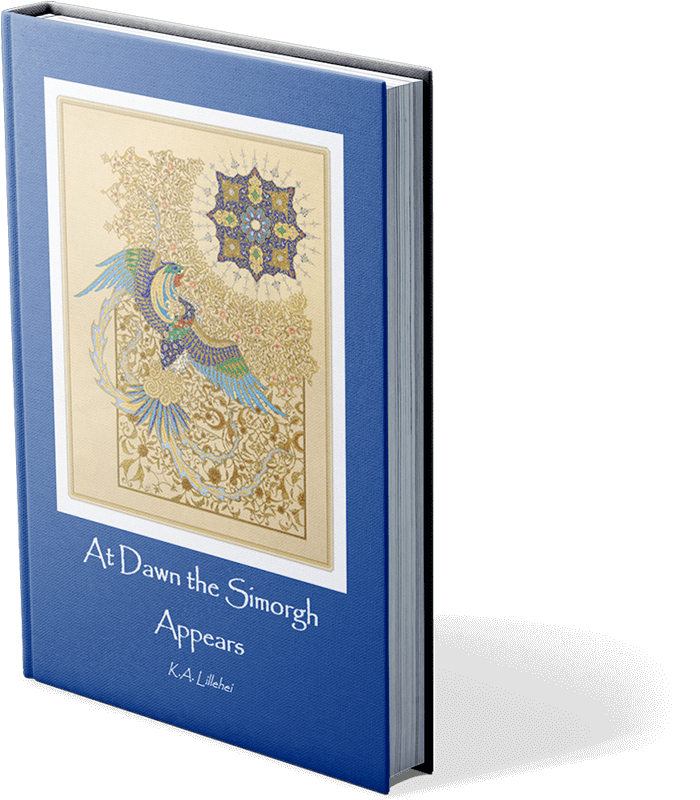At Dawn the Simorgh Appears
by K.A. Lillehei

synopsis
A stone cell, pitch black, cold and dusty. Two women struggle to escape not knowing who took them nor why. While exploring an ancient Persian archeological site, Anna and Farah were taken by a gang of renegades, thrown in a truck and driven for hours into the mountainous high desert. Held captive for days awaiting the arrival of the gang leader, they share their fears, but also memories of childhood and families, joys and sorrows.
Using their wits and courage, will they be able to escape? For all their external differences, Anna and Farah discover a bond – commonalities, shared ideologies and beliefs. Superficially they are as different as night and day. Sisters beyond time, language, culture and religion. Like modern-day Scheherazades, through their stories the women discover a universe where their outer worlds divide, but their inner worlds connect.
available formats
-
Paperback
-
Kindle
book details
Type |
Tale/Fiction |
ASIN: |
B08P7ZHFKC |
Publication date: |
November 26, 2020 |
Kindle Pages: |
224 |
Paperback Pages: |
395 |
BookLife Talks with K.A. Lillehei
Set in the 1970s and following the lives of two women, Lillehei’s At Dawn the Simorgh Appears is based on the poem “The Conference of the Birds” by Farid ud-Din Attar, which was written in 1177 and is part of the Persian epic about the mythical Simorgh, a gigantic and kindhearted bird.
Your Title Goes Here
Your content goes here. Edit or remove this text inline or in the module Content settings. You can also style every aspect of this content in the module Design settings and even apply custom CSS to this text in the module Advanced settings.
What is the story behind this? Why and how did you write it?
What was your writing process like?
What kind of research did you do to ensure the historical and cultural accuracy?
How do you imagine readers at this moment will connect to At Dawn the Simorgh Appears?
Are you working on a new project?
book reviews
Anna, a professor from the Pacific Northwest, met Farah in Paris. She hired Farah to interpret Persian for her at ancient Iranian ruins. The excursion takes a dangerous turn when armed men kidnap the women and drive them to a holding cell. Now, Anna and Farah suffer darkness, strange animals sniffing at the door of their stone prison, and the stress of an unknown fate. To maintain their courage, the women exchange memories of childhood. Farah talks of her beloved father and sisters and time spent in a poppy field. Anna remembers a lonely but satisfying life with her grandparents on Bainbridge Island, surrounded by books and horses. Eventually, a young boy named Samir brings the prisoners bread, cheese, and water. Through his visits, they learn of tension among the gunmen. Some follow the commander, Arash, whom Anna finds striking from a distance. Others obey the vicious upstart, Hassan, who was part of a group that killed Samir’s mother and sister. While examining Anna at knife point, Hassan lightly draws the blade across her flesh to threaten her. Even if the women do escape, they may not get far. Lillehei’s novel embodies how Anna feels about the desert, which possesses beauty that she finds to be “subtle and hidden.” Tightly held secrets inform several characters’ arcs, the most shocking being Samir’s. Readers learn about Persian language (“joon” means soul) and myth. The simorgh is the “eternal bird that nests in the Tree of Knowledge, messenger between sky and earth.” How this legend relates to the plot may require patience from audiences who prefer overt spectacle in their epic adventures. The author does crank up the tension incrementally, but the burgeoning friendship between the analytical Anna and the emotional Farah remains the focus. Lovely moments abound, as when “the azure skies” and “the pastel array of colors of the air where it met the white wisps of cloud” summon the women home. A key incident leads one of the protagonists to an intriguing finale.
A grandly emotional piece that celebrates family and the overlap between Eastern and Western values.
At Dawn the Simorgh Appears by K.A. Lillehei is a wonderfully colorful story that will transport you into the beautiful landscape of the Middle East. The descriptive detailed narrative brings everything to life, from the musty prison cell to the fragrant mountains. The main characters have distinguishable personalities and although they are so different, they gather strength from each other as they try to escape the prison of their painful memories. The plot moves at a fast pace and the obstacles they have to face before and after their escape builds great tension. With Anna and Farah sharing the emotional stories of their past, it builds a great backstory for their characters. Anna is an inspirational woman with an enviable strength while Farah’s sensitivity is heartwarming. The story also highlights the ancient cultures and architecture of the Middle East. There is also an important message threaded throughout the story of how people faced with difficult childhoods can make life-changing choices that will take them on different life paths. The ending was a surprise twist and does leave room for a sequel.
When an opportunity to escape arises, the two women take advantage of it. A young nomad boy, Samir, who is at the bandits’ hideout, flees with them in a stolen jeep. They get help from a group of nomadic tribespeople, and K.A. Lillehei includes interesting details about people who live a nomadic lifestyle. Anna, Farah, and Samir are guided by one of the young nomads through the Zagros mountain range, which are located in Iran and along the border areas of Iraq and Turkey. The plan is for the three freed prisoners to cross the border into Iran. Will they make it safely to Iran before the dangerous men catch up with them? If they survive, what kind of effect will this horrible ordeal have on their everyday lives?
At the beginning of this enthralling novel, Lillehei captures readers’ attention with an excerpt from a story about the Simorgh, a compassionate female winged creature that appears in Iranian mythology as a benefactor to those in need. In chapter one Anna and Farah are discussing the shock and lack of understanding regarding their kidnapping and incarceration. Readers will empathize with their predicament and want to know the outcome. Throughout the book are excerpts of memories from the lives of the three escapees, along with mythological tales about strong women. All of the recollections and mythic tales play a crucial part in the storyline.
Anna and Farah have experienced far different cultural and lifestyle backgrounds. However, as the two women share their innermost thoughts and feelings about themselves a strong bond of friendship develops between them, which is wonderfully illustrated throughout the story. Anna studies ancient civilizations and converses with Farah in English and Farsi. Persian and Arabic words and/or phrases are used throughout the story, and Lillehei provides translations so there is no confusion about their meanings. Usage of metaphors adds depth to the text that conjures up images, thoughts, and feelings in readers’ minds. This is an outstanding book that shows the strength of femininity in the face of monumental obstacles and how cultural background influences the manner in which people learn, live, and behave.


